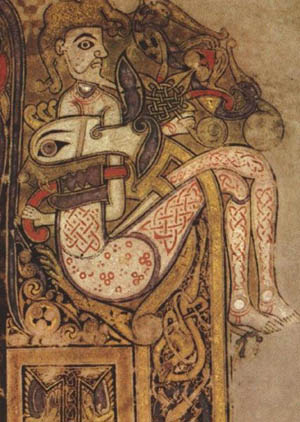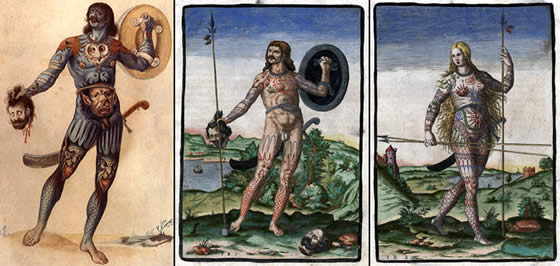Mason Marks: Tattoos of Saint John
 During the course of my research into ancient tattoos, I had come across this fascinating book on Gnosticism written during the 18th century. The book is titled, The Gnostics and Their Remains, Ancient and Mediaeval by Charles William King and in it the author describes this mysterious tattooed man that adorns the artwork of the Book of Kells. He also relates these tattoos to a fascinating and believable connection between Ptolemy Philopator who had received Dionysiac brand-marks, St John, Masonic Brand marks and biblical prophecy.
During the course of my research into ancient tattoos, I had come across this fascinating book on Gnosticism written during the 18th century. The book is titled, The Gnostics and Their Remains, Ancient and Mediaeval by Charles William King and in it the author describes this mysterious tattooed man that adorns the artwork of the Book of Kells. He also relates these tattoos to a fascinating and believable connection between Ptolemy Philopator who had received Dionysiac brand-marks, St John, Masonic Brand marks and biblical prophecy.
This reference to the Book of Kells I had confirmed in my own library by seeing this man that is obviously heavily tattooed in a blue ink. There is also another tattooed man with blond hair covered with red Celtic knot tattoos that is pictured to the left.
It is interesting to connect the tattoos left by these ancient brothers and sisters from Egypt, to Greece, and then to the West in countries such as Gaul, Ireland, Scotland and Denmark. These revelations are just more historical clues that add to the mounting apocalyptic physical evidence that has been left by these peoples for us historians.
Below is the excerpt that I’m writing about from the book, The Gnostics and Their Remains, Ancient and Mediaeval;
“The Book of Kells” is a MS., written some time in the ninth century. In one of the facsimiles of its pages published by the Palæographical Society, amongst the ornamentation of one vast initial letter, the most conspicuous is the figure of a naked man, writhing himself amongst its most intricate convolutions.
This man’s body is entirely covered with “marks” of various forms; and from the circumstances under which the drawing was made we can safely assume that we have here preserved to us the portrait of a true Pict, taken from the life. (more…)

Moe is the founder of GnosticWarrior.com. He is a father, husband, author, martial arts black belt, and an expert in Gnosticism, the occult, and esotericism.

